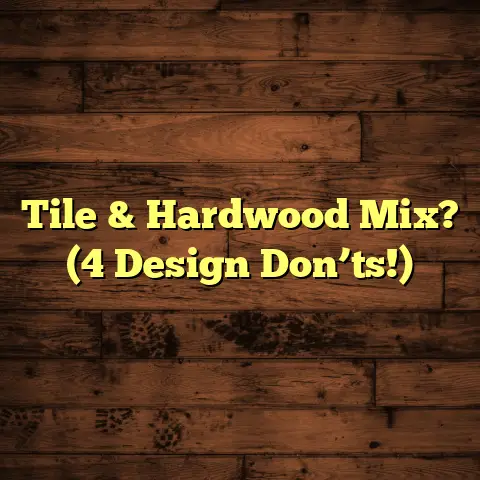Vacuum Wood Floors? (5 Mistakes Costing You!)
We’re talking aesthetics – that warm, inviting look. Durability – floors that can handle the hustle and bustle of daily life. And ease of maintenance – who doesn’t want a floor that’s simple to keep clean?
According to a recent study by the National Wood Flooring Association (NWFA), hardwood floor installations have risen by almost 30% in the last decade. That’s huge!
But here’s the thing: owning beautiful wood floors comes with responsibility. And one of the biggest culprits I see in damaging these floors? Improper vacuuming!
Trust me, I’ve seen it all. So, let’s dive in and make sure you’re not accidentally ruining your gorgeous investment.
Section 1: Understanding Wood Floors
So, what exactly is hardwood flooring? Simply put, it’s flooring made from a single piece of wood. Think oak, maple, walnut, cherry – the classics!
Now, you’ve probably heard of engineered hardwood too. This is where things get a little different. Engineered hardwood has a thin layer of real hardwood on top of a plywood or fiberboard core. It’s more resistant to moisture and can be a great option for basements or areas with high humidity.
What are the benefits of choosing hardwood? Let me break it down:
-
Lifespan: With proper care (and yes, proper vacuuming!), hardwood floors can last for decades, even generations!
-
Environmental Impact: Wood is a renewable resource, making it a more sustainable choice than some other flooring options.
-
Resale Value: Let’s be honest, beautiful hardwood floors are a major selling point when it comes time to move.
Vacuuming is essential for keeping those floors looking their best. It removes the dirt, dust, and debris that can scratch the finish and dull the shine.
Section 2: Mistake #1 – Using the Wrong Vacuum
Okay, this is a big one. Not all vacuums are created equal, especially when it comes to wood floors.
What kind of vacuums should you be using? I generally recommend these:
-
Canister Vacuums: These are my go-to. They have excellent suction and come with a variety of attachments, including soft brush heads specifically designed for hardwood.
-
Stick Vacuums: These are lightweight and convenient for quick cleanups. Just make sure they have a soft brush roll or the option to turn the brush roll off.
So, what’s the WORST thing you can do? Using an upright vacuum with a beater bar (that rotating brush) directly on your hardwood.
I’ve seen so many floors damaged by these aggressive brushes! They can scratch the finish, leaving unsightly marks and dulling the overall appearance.
For example, I had a client call me in a panic after using her old upright vacuum on her newly installed oak floors. The beater bar had left swirl marks all over the surface. It was a costly mistake!
Here are a few vacuums specifically designed for wood floors that I often recommend:
-
Bissell Zing Bagless Canister Vacuum: A budget-friendly option with good suction and a gentle brush head.
-
Dyson V8 Absolute Cordless Stick Vacuum: A powerful and versatile stick vacuum with a soft roller cleaner head perfect for hardwood.
-
Miele Complete C3 Calima Canister Vacuum: A premium option with exceptional filtration and a variety of attachments for all types of flooring.
Section 3: Mistake #2 – Neglecting Regular Vacuuming
Think about it: your floors are constantly bombarded with dust, dirt, pet hair, and allergens. It’s a never-ending battle!
Neglecting to vacuum regularly allows these particles to accumulate, leading to some serious problems.
First, there are the scratches. Those tiny particles act like sandpaper, grinding against your floor’s finish with every footstep. Over time, this can lead to visible scratches and a dull appearance.
Then there’s the issue of indoor air quality. Dust and allergens trapped in your floors can circulate through your home, triggering allergies and respiratory problems.
According to the EPA, indoor air can be two to five times more polluted than outdoor air!
How often should you be vacuuming? I generally recommend:
-
High-Traffic Areas: Daily vacuuming
-
Moderate-Traffic Areas: Every other day
-
Low-Traffic Areas: 2-3 times per week
Of course, this depends on your lifestyle. If you have pets or kids, you’ll likely need to vacuum more often.
I had a client with two large dogs who thought vacuuming once a week was enough. Needless to say, her floors were covered in pet hair and looked dull and lifeless. After increasing her vacuuming frequency to every other day, she noticed a HUGE difference in the appearance of her floors and the air quality in her home.
Section 4: Mistake #3 – Skipping Proper Vacuuming Techniques
Even if you have the right vacuum and vacuum regularly, you can still damage your floors if you’re not using the correct techniques.
What’s the best way to vacuum? Here are a few tips:
-
Vacuum in the Direction of the Wood Grain: This helps to lift dirt and debris from the grooves in the wood.
-
Use the Right Attachments: A soft brush attachment is essential for hardwood floors. Avoid using attachments with stiff bristles or rough edges.
-
Overlap Your Strokes: This ensures that you’re covering the entire surface of the floor.
What are some common mistakes I see?
-
Vacuuming Too Quickly: Rushing through the job doesn’t allow the vacuum to properly suction up dirt and debris.
-
Neglecting Corners and Edges: These areas tend to accumulate more dust and dirt, so it’s important to pay attention to them. Use the crevice tool attachment to reach these tight spaces.
-
Dragging the Vacuum Cord: This can scratch your floors, especially if the cord is dirty or has a metal end.
I once watched a homeowner vacuum her floors like she was racing against the clock. She zipped across the room, barely touching the surface, and completely ignored the corners and edges. It was no surprise that her floors looked dull and dirty, even after vacuuming!
Section 5: Mistake #4 – Over-Vacuuming or Under-Vacuuming
Yes, you can actually vacuum too much! It’s a delicate balance.
Over-vacuuming can wear down the finish on your floors over time. All that friction, even with a soft brush, can take its toll.
On the other hand, under-vacuuming allows dirt and debris to accumulate, leading to scratches and dullness.
So how do you find the sweet spot? It depends on a few factors:
-
Foot Traffic: High-traffic areas require more frequent vacuuming.
-
Pets: Pets shed hair and track in dirt, so you’ll need to vacuum more often if you have furry friends.
-
Climate: Dry climates tend to produce more dust, while humid climates can trap dirt and allergens in your floors.
I had a client who was obsessed with keeping her floors spotless. She vacuumed them every single day, sometimes twice a day! While her floors were certainly clean, the finish was starting to wear down in high-traffic areas. I advised her to reduce her vacuuming frequency to every other day, and she noticed a significant improvement in the appearance of her floors.
Section 6: Mistake #5 – Not Maintaining the Vacuum
Think of your vacuum as an extension of your floor! If it’s dirty or not working properly, it can actually damage your floors.
Here’s what you need to do to keep your vacuum in tip-top shape:
-
Change Filters Regularly: Dirty filters reduce suction and can circulate dust and allergens back into the air. Check your vacuum’s manual for recommended filter replacement intervals.
-
Empty Canisters Frequently: A full canister reduces suction and can cause the vacuum to overheat.
-
Clean Brush Rolls: Hair, string, and other debris can get tangled in the brush roll, reducing its effectiveness. Use scissors or a seam ripper to remove any tangled debris.
-
Check for Clogs: Clogs in the hose or attachments can reduce suction and cause the vacuum to overheat.
I once had a client complain that her vacuum wasn’t picking up dirt properly. When I checked the vacuum, I found that the filter was completely clogged with dust and pet hair. After replacing the filter, the vacuum worked like new!
Here’s a handy checklist for vacuum maintenance:
- [ ] Check and empty the dustbin or bag after each use.
- [ ] Clean the brush roll every month.
- [ ] Replace the filter every 3-6 months (depending on usage).
- [ ] Check for and remove any clogs in the hose or attachments.
- [ ] Inspect the power cord for damage.
Conclusion
Alright, we’ve covered a lot of ground! Let’s recap the key takeaways:
-
Use the Right Vacuum: Avoid upright vacuums with beater bars. Opt for a canister or stick vacuum with a soft brush attachment.
-
Vacuum Regularly: Don’t let dust and dirt accumulate. Vacuum high-traffic areas daily and low-traffic areas 2-3 times per week.
-
Use Proper Techniques: Vacuum in the direction of the wood grain, use the right attachments, and overlap your strokes.
-
Don’t Over-Vacuum or Under-Vacuum: Find the right balance based on your lifestyle and the amount of traffic your floors receive.
-
Maintain Your Vacuum: Keep your vacuum clean and in good working order to ensure optimal performance.
Take a moment to think about your own vacuuming habits. Are you making any of these mistakes? If so, don’t worry! It’s never too late to make a change.
By following these tips, you can keep your wood floors looking beautiful for years to come. Trust me, your floors (and your wallet) will thank you!





